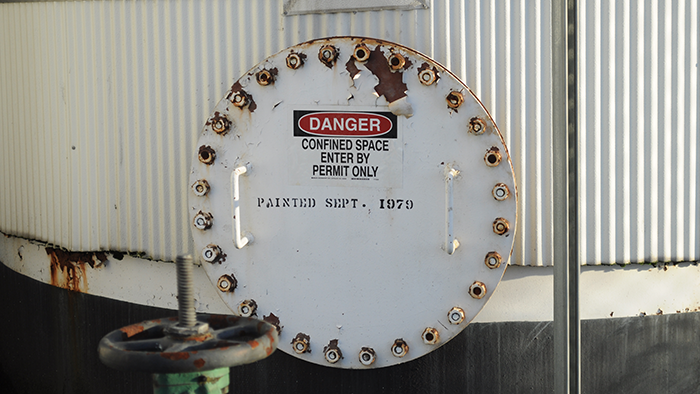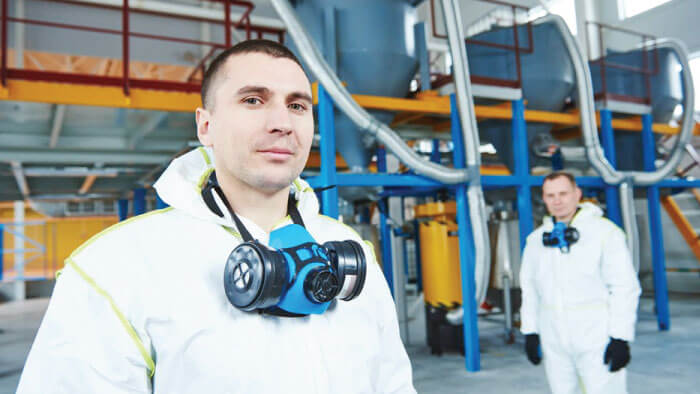Confined Space – Federal vs. Provincial
Feb 26, 2021 Confined Space, Occupational Health & Safety RegulationsAnyone else notice that working from home can be a challenge? I am not talking about the safety aspect of it that we recently covered in another post, but the staying focused piece.
The whole eyes on task, mind on task – staying in “work mode” and not getting distracted occasionally become the inevitable (TikTok is filled with humorous examples btw).
As a diligent worker, however, when my mind wanders, I do my best to keep it as work-related as possible: enter the Canadian Gazette.
I’m sure you all remember hearing in like grade 9 civics class that things the government does get posted in a Gazette (federal and provincial versions depending) – and you see where this is going? Yep! I have been reading it to fill… I mean, utilize my work time.
Recently I stumbled upon “Canada Gazette, Part I, Volume 154, Number 25: Regulations Amending the Canada Occupational Health and Safety Regulations (Part XI)” from June 2020.
How did I miss this when it was right of the preverbal press? I’ll never know 😊.
Silliness aside, it speaks about the amendments to the federal regulations on working in confined spaces to modernize and bring them into line with provincial laws. As a trainer who teaches O. Reg 632 (Confined Spaces), it had me wonder what the differences are between federal and provincial.

Moreover, I thought this would be an excellent opportunity to discuss some elements found in awareness and entry vs rescue planning obligations.
Confined Spaces Definition
The federal regulations (SOR/86-304) define a confined space as:
“an enclosed or partially enclosed space that (a) is not designed or intended for human occupancy except for the purpose of performing work, (b) has restricted means of access and egress, and (c) may become hazardous to any person entering it owing to (i) its design, construction, location or atmosphere, (ii) the materials or substances in it, or (iii) any other conditions relating to it.”
Sounds pleasant, doesn’t it? It’s a work area most of us wouldn’t want to be.
What is essential to take away from this is that it isn’t meant for people to be in, it has limited entry and exit points, and it’s hazardous due to the design (such as entrapment points) and atmosphere (oxygen levels), or substances (immediately dangerous to life or health, lower explosive limits) found there.
Provincially a confined space means:
“a fully or partially enclosed space, (a) that is not both designed and constructed for continuous human occupancy and (b) in which atmospheric hazards may occur because of its construction, location or contents or because of work that is done in it” (O. Reg 632).
While the definitions are slightly different in prose, they are similar with intent.
Unique to the circumstances and specific in terms of obligation – measures and procedures have to be put in place if a worker is required to enter the work area that meets these definitions.
With me so far? Alright, time to get a little technical.
Now, if you are reading this, you no doubt have a reason to be. Either your organization is currently involved in confined space work or is about to be. So, let’s go over the requirements before you even start preplanning. O. Reg 632 S. 5 (1) states:
“If a workplace includes a confined space that workers may enter to perform work, the employer shall ensure that a written program for the confined space is developed and maintained in accordance with this Regulation before a worker enters the confined space.”
This means without this program, no one goes in the hole, tank, vat, etc.
Confined Space Program
It is essential to know that your program may cover more than one confined space in your workplace; but area-specific items must be addressed in a risk assessment (more to come on that).
O. Reg 632 S. 5 (3) adds an additional requirement of getting the JHSC involved in the process of program development, partially to take the burden off the employer, but more so to ensure worker JHSC representatives are satisfied that the regulations have been met, and the workers are protected.
Elements your program must include are:
- a method for recognizing each confined space to which the program applies
- a method for assessing the hazards to which workers may be exposed (atmospheric, design, construction, layout, the by-product of work being done, etc.)
- a method for developing one or more plans (duties of workers, on-site rescue, energy isolation, etc.)
- a method for the training of workers (hazard recognition and plan specific elements), and
- an entry permit system that sets out the measures and procedures to be followed when work is to be performed in a confined space to which the program applies. O. Reg 632 S. 5 (4).
Any of this sound familiar? If not, keep reading, and we will cover training options at the end.
Now federally regulated confined spaces are similar, but a few differences do become apparent.
Before a worker is allowed to enter, a hazard assessment must be completed, including identifying any of the elements previously mentioned, and this assessment has a three-year validity period (SOR/86-304 S.11.2 (4)).
The employer is then obligated to create entry procedures in consultation with the workplace safety committee, which covers entry permits and the anticipated expiry, authorized entrants, required protective equipment, permitted tools, and any rescue equipment that may be required (SOR/86-304 S.11.3).
The hazards of engulfment, energy isolation, mechanical process, and atmosphere must be tested and recorded before entry.
So far, so good. Other than the federal 3-year expiry to the hazard assessment, the two jurisdictions essentially require the same things.
Speaking of hazard assessments, more precisely about atmospheric hazards, my provincially minded brain has spotted something federally:
“the percentage of oxygen in the air in the confined space is not less than 18 percent by volume and not more than 23 percent by volume, at normal atmospheric pressure” SOR/86-304 S.11.4(1)(a)(iii)
Huzzah! A difference!
The oxygen levels differ from Ontario. Reg 632 requirements, “an oxygen content in the atmosphere that is less than 19.5 percent or more than 23 percent by volume”.
If you took anything from this post so far, you now have the three differences between provincial and federal requirements for confined spaces ready for use in your workplace, or for trivia night with your friends, either or I’m good with.
With such minor differences in terms of definitions, validity periods of assessments, or oxygen levels, you could question why?
Why is one different from the other? I am not going to lie; I am rather curious… however, that’s not the point here. We want to ensure compliance with the regulation that applies to us and, in terms of due diligence, follow what offers our workers the most significant safety level.
I can sum up confined space in four roles.
- The entrant – This is the person that goes into the hole, tank, vat, etc.
- The attendant – This is the person who watches the person that goes into the hole, tank, vat, etc.
- The rescuer – This is the person who hopes they will never have to go into the hole, tank, vat, etc.
- The employer – This is the person/designate who ensures that those involved above follow the plan and program for the hole, tank, vat, etc.
Training Requirements

Time to finally get back to that training element I mentioned earlier. What type of training do you or your workers need? Awareness vs rescue training is a question we as a company get all the time. Well, I think it depends on where you fit into your organization’s confined space program.
I’m going to reference the four roles to separate workers into training requirements.
As the workers performing the work and monitoring the hazards identified as part of your risk assessment, the entrant and attendant would need awareness training. These two roles need to be able to:
- Become more aware of confined space hazards and hazard controls.
- Be able to recognize confined spaces and related hazards.
- Be able to identify elements of an effective confined space program.
- Understand the roles and responsibilities of the authorized entrant and safety attendant
- Understand what provisions must be in place for safe entry, communications and on-site rescue capabilities.
- Be able to understand the provisions required for the entry permit.
- Have knowledge of hazards that may be faced during entry, including the signs, symptoms, modes and consequences of the exposure.
As the rescuer(s), well, you have slightly different needs. Awareness training is a must, but additional training is needed for your role. O. Reg 632 S. 5 (11) state the obligations for on-site rescue procedures:
“(1) The employer shall ensure that no worker enters or remains in a confined space unless, in accordance with the relevant plan, adequate written on-site rescue procedures that apply to the confined space have been developed and are ready for immediate implementation. (2) Before a worker enters a confined space, the employer shall ensure that an adequate number of persons trained in the matters listed in subsection (3) are available for immediate implementation of the on-site rescue procedures mentioned in subsection (1).”
So, this is something that you need to have but will be specific to your confined space program. It continues with:
“(3) The persons shall be trained in, (a) the on-site rescue procedures mentioned in subsection (1); (b) first aid and cardio-pulmonary resuscitation; and (c) the use of the rescue equipment required in accordance with the relevant plan.”
Equipment may consist of tripods, SCBA’s and gas dectors, to name a few.
So based on these requirements, if a member of your JHSC or I asked the designated rescuers questions about the methods of rescue, the equipment used, its inspections, and deployment – would they be able to answer these questions as per your program?
Ideally, yes, but not always. So, they need to be trained in awareness and rescue.
Lastly, the employer/designate. Well, I hope this will be a short paragraph… considering what has been covered above, and based on the OHSA S.25 (2) (a)(d) requirements for providing information, instruction, etc.… what do you think you would require in this role to ensure all of the above is being complied with in your organization? For your confined spaces?
Ultimately, you have to prove you took all precautions reasonable in the circumstance for the worker’s protection.
Well, what a wild ride that was! Who knew browsing the government websites, killing, I mean, maximizing my time working from home would cover so much? So, as it turns out, dealing with confined spaces – both federally and provincially will be very similar.
The entry plans, hazard assessments, and rescue components more or less align.
Realistically though, nothing much has changed.
Our workers are still our top priority, and regulations set out the least we can do – but we can always do better. If people don’t go home at the end of the day, the trivia tips I gave you earlier could become charges, and no one wants those.
Geoff Rowatt
Health & Safety Trainer | CHRP | CHRL





